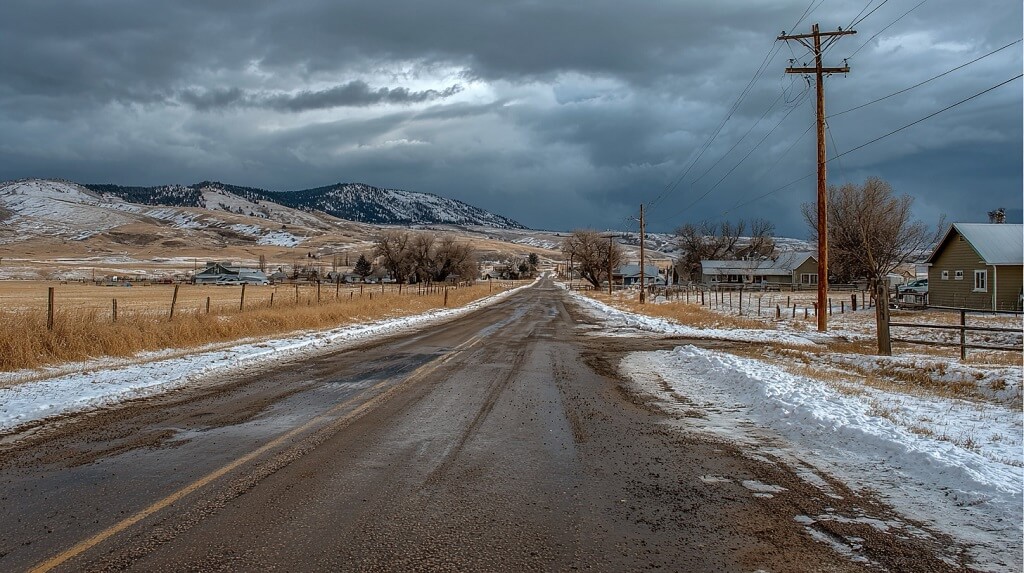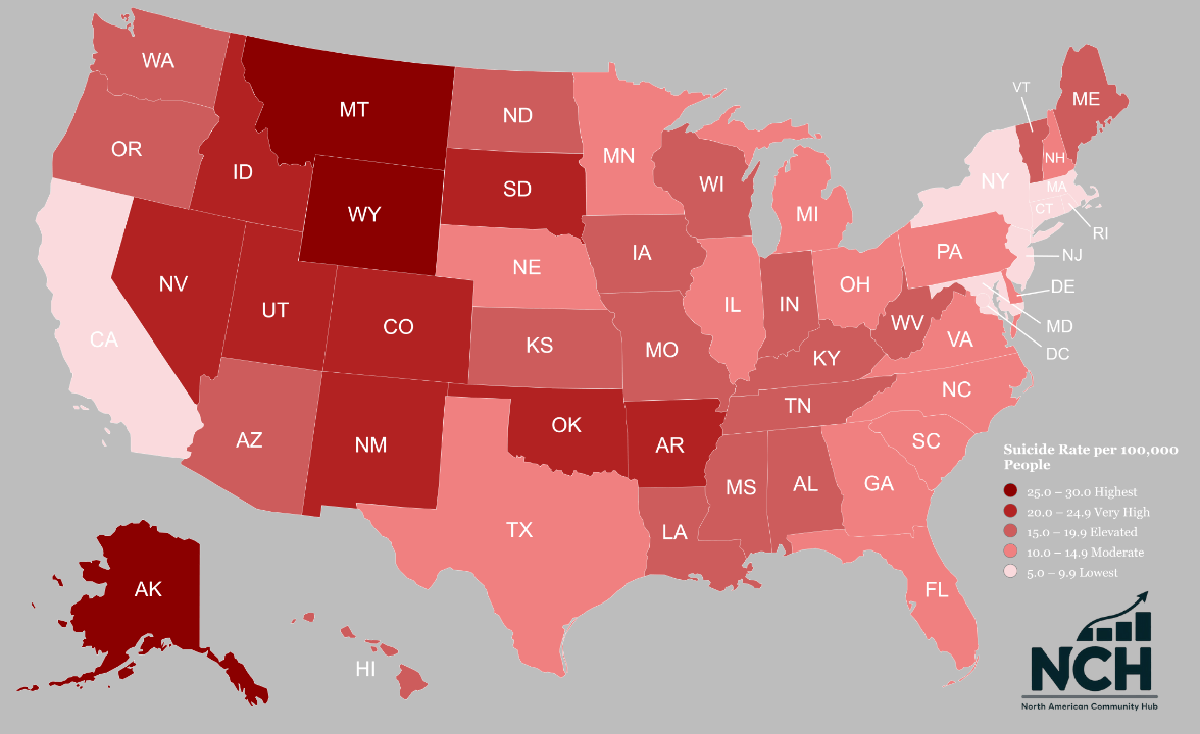Suicide rate in the United States remains alarmingly high, with tens of thousands of lives lost each year.
Many victims include veterans, teenagers, parents, and neighbors who moved through daily routines while carrying pain that stayed hidden.
Experts in public health cite isolation, severe stress, financial pressure, and limited access to mental health care as major forces pushing suicide rate numbers upward across many regions.
Recent data shows little movement toward safer conditions. An estimated 48,800 suicide deaths occurred in 2024, a figure that underscores the scale of the crisis and the strain placed on families and communities.
A closer look at suicide rate trends over recent years will show where the numbers rise, where they fall, which age groups face the highest risk, and how the crisis spreads across different parts of the country.
Comparison of Suicide Rates in the US Year by Year(2000 to 2025)
Reviewing the trend from 2000 to 2025 gives us a long view of where the problem has been, where it is, and where it may go.
The numbers below trace a 25-year picture of suicide in the United States.
| Year | Total Suicides | Age-Adjusted Rate per 100,000 |
|---|---|---|
| 2000 | 29,350 | 10.4 |
| 2001 | 30,622 | 10.7 |
| 2002 | 31,655 | 10.9 |
| 2003 | 31,484 | 10.8 |
| 2004 | 32,439 | 11.0 |
| 2005 | 32,637 | 10.9 |
| 2006 | 33,300 | 11.0 |
| 2007 | 34,598 | 11.3 |
| 2008 | 36,035 | 11.6 |
| 2009 | 36,909 | 11.8 |
| 2010 | 38,364 | 12.1 |
| 2011 | 39,518 | 12.3 |
| 2012 | 40,600 | 12.6 |
| 2013 | 41,149 | 12.6 |
| 2014 | 42,826 | 13.0 |
| 2015 | 44,193 | 13.3 |
| 2016 | 45,000 | 13.5 |
| 2017 | 47,173 | 14.0 |
| 2018 | 48,344 | 14.2 |
| 2019 | 47,511 | 13.9 |
| 2020 | 45,979 | 13.5 |
| 2021 | 47,646 | 14.0 |
| 2022 | 49,449 | 14.2 |
| 2023 | 49,316 | 14.1 |
| 2024* | 48,800 | 14.0 |
| 2025* | 49,100 | 14.1 |
* Figures for 2024 and 2025 are estimates based on early national reports. We will update this information once the full research is available. Final verification will come through the National Vital Statistics System once full-year data are confirmed.
The Numbers Keep Going Up

Data on the suicide rate in the United States shows a rise that spans more than twenty years. Every new report confirms the same direction.
The number of deaths climbs, the rate climbs, and the impact reaches every part of the country.
In 2000, the suicide rate sat a little above ten deaths for every one hundred thousand people. By 2025, the suicide rate in the United States rises past fourteen.
The increase may look small as a number on a chart, yet each point reflects thousands of lives lost and thousands of families changed forever.
Between 2002 and 2018, the national suicide rate rose by more than thirty percent. A brief dip around 2019 and 2020 created hope for a turning point, but the drop did not last.
Rates in the United States returned to record levels and continue to hold there.
Men remain at the highest risk. Older adults show some of the most severe rates.
Suicide stands as the second leading cause of death for Americans aged 10 to 34, a trend that should unsettle anyone who follows public health data.
Researchers and crisis teams point to several core pressures that shape the suicide rate in the United States: financial strain, loneliness, housing stress, and long waits for mental health care. Many people in crisis cannot reach help in time, and that gap fuels the ongoing rise.
Only a small group of states has managed to push rates downward, and even those gains remain fragile.
Suicide Rates by State in the United States
Suicide rate in the United States varies sharply from state to state, and the gap between the highest and lowest creates two very different national maps.
Several western and rural states carry the heaviest burden. Alaska, Montana, and Wyoming continue to record the highest suicide rates in the country, often above 25 deaths for every 100,000 residents. Their numbers stay near the top year after year.
Large northeastern states show the lowest rates. New Jersey, New York, and Massachusetts remain on the opposite end of the scale, frequently reporting suicide rates below 10 deaths per 100,000 residents. Their trend has stayed stable for a long time and stands out against the national rise.
The contrast between these two groups highlights how uneven the suicide rate in the United States has become and why regional patterns matter when looking at the larger crisis.
Here are the details about all states.
| Rank | State | Suicide Rate (per 100,000) | Suicides |
|---|---|---|---|
| 1 | Alaska | 28.2 | 206 |
| 2 | Montana | 26.6 | 310 |
| 3 | Wyoming | 26.3 | 157 |
| 4 | Idaho | 23.3 | 460 |
| 5 | New Mexico | 22.8 | 489 |
| 6 | Oklahoma | 21.8 | 893 |
| 7 | Utah | 21.5 | 706 |
| 8 | Colorado | 20.9 | 1,297 |
| 9 | South Dakota | 20.7 | 181 |
| 10 | Nevada | 20.3 | 690 |
| 11 | Arkansas | 20.2 | 626 |
| 12 | Kansas | 19.6 | 569 |
| 13 | Oregon | 19.4 | 888 |
| 14 | Arizona | 19.2 | 1,506 |
| 15 | West Virginia | 18.6 | 349 |
| 16 | Maine | 18.5 | 274 |
| 17 | Missouri | 18.0 | 1,143 |
| 18 | North Dakota | 17.8 | 142 |
| 19 | Vermont | 17.8 | 125 |
| 20 | Kentucky | 17.5 | 813 |
| 21 | Tennessee | 17.3 | 1,279 |
| 22 | Indiana | 17.0 | 1,187 |
| 23 | Alabama | 16.8 | 869 |
| 24 | Washington | 15.7 | 1,287 |
| 25 | Louisiana | 15.6 | 719 |
| 26 | Iowa | 15.5 | 504 |
| 27 | Mississippi | 15.5 | 457 |
| 28 | Hawaii | 15.3 | 223 |
| 29 | Wisconsin | 15.0 | 920 |
| 30 | Michigan | 14.9 | 1,529 |
| 31 | Georgia | 14.8 | 1,670 |
| 32 | Ohio | 14.7 | 1,792 |
| 33 | South Carolina | 14.7 | 818 |
| 34 | New Hampshire | 14.6 | 221 |
| 35 | Nebraska | 14.5 | 284 |
| 36 | Florida | 14.4 | 3,620 |
| 37 | North Carolina | 14.3 | 1,597 |
| 38 | Pennsylvania | 14.3 | 1,976 |
| 39 | Texas | 14.2 | 4,382 |
| 40 | Minnesota | 13.8 | 812 |
| 41 | Virginia | 13.6 | 1,243 |
| 42 | Delaware | 12.8 | 144 |
| 43 | Illinois | 11.9 | 1,567 |
| 44 | California | 10.2 | 4,200 |
| 45 | Rhode Island | 9.4 | 112 |
| 46 | Maryland | 9.3 | 599 |
| 47 | Connecticut | 9.1 | 356 |
| 48 | Massachusetts | 8.6 | 658 |
| 49 | New York | 8.3 | 1,717 |
| 50 | New Jersey | 7.2 | 709 |
| 51 | District of Columbia | 6.8 | 50 |
The States Where the Crisis Runs Deep
Some parts of America carry a heavier burden than others.
Numbers from Alaska, Montana, and Wyoming reveal a pattern that feels distant to most, yet painfully close to the people living it.
Each of those states continues to record suicide rates far above the national level, shaped by forces that go far beyond statistics.
1. Alaska

Alaska holds the highest rate in the nation, 28.2 deaths for every 100,000 people, with about 206 lives lost in a single year.
In a state where winter lasts most of the year and towns are separated by hundreds of miles, reaching help is not simple.
Many areas have no local counselors or clinics. Families face isolation, alcohol abuse, and economic stress that push them to the edge.
Health workers describe a cycle that repeats itself quietly across small communities with too few resources to stop it.
2. Montana
Montana follows with 26.6 deaths for every 100,000 people, roughly 310 deaths in total.
It is a place known for its open land and tight-knit towns, yet that same openness can turn into isolation.
Most suicides there involve firearms kept in the home. Reports show many people had been dealing with chronic pain or personal loss before their deaths.
Mental health care is hard to find outside the major cities. Volunteers and local leaders have started small prevention efforts, but the gap between knowing the risk and finding real help remains wide.
3. Wyoming

Wyoming is close behind, with 26.3 deaths for every 100,000 people, about 157 lives lost.
The economy rises and falls with oil, mining, and agriculture, and those changes hit families hard. People there pride themselves on being strong and independent, which makes it even harder to ask for help.
Firearms are common, and most suicides involve one. State programs now teach gun owners about safe storage and crisis signs, but many residents still face their pain alone.
Other States with Alarming Suicide Rates
Beyond Alaska, Montana, and Wyoming, several other states face the same crisis in silence. Places like Idaho, New Mexico, and Oklahoma show patterns that are impossible to ignore.
Each of them records suicide rates above 20 deaths per 100,000 people, well above the national level.
Idaho reports a rate of 23.3 deaths per 100,000, with about 460 deaths. Rural counties see the highest numbers, where poverty and lack of services leave many people alone with their pain.
New Mexico follows with 22.8 deaths per 100,000, roughly 489 deaths in total. Experts in Albuquerque and Santa Fe link much of the problem to substance abuse, poverty, and gaps in behavioral health treatment. Indigenous and rural communities carry a large share of the loss, with cultural and economic barriers making it harder to reach consistent care.
Oklahoma stands at 21.8 deaths per 100,000, with an estimated 893 deaths. Mental health providers in the state describe a shortage of trained professionals and long waiting lists for therapy. Firearms are involved in most suicides, and many victims had shown warning signs that went unnoticed.
The story repeats in Utah and Colorado, where rates also remain above 20 per 100,000.
What About the Highly Populated States?
Large populations hide how serious the problem really is. The suicide rate might look lower on paper, but the number of people dying is still staggering.
California loses about 4,200 people each year. The rate sits at 10.2 per 100,000, which sounds low until you realize it adds up to thousands of lives gone.
Big cities have mental health programs, but rural counties fall behind, leaving long waits for anyone seeking help.
Texas reports around 4,382 deaths and a rate of 14.2. The size of this state alone makes access to care difficult.
People living hours from the nearest therapist often face stress, debt, or health problems alone.
Florida records about 3,620 deaths at a rate of 14.4. Many deaths happen outside the major cities, in areas with fewer doctors and weak local support systems.
New York has about 1,717 deaths, with a rate of 8.3.
Numbers are lowest in New York City but much higher in upstate counties, where hospitals and counselors are spread thin.
The data tell a hard truth. Suicide remains a national crisis that no state escapes.
Now, let’s see what the situation is around the world, and if other countries are facing the same challenges.
Global Suicide Rates by Country
Suicide remains a serious issue in every region of the world, and the numbers show clear differences from one country to another. Some nations face far heavier loss than others, even when the global average sits at 9.2 deaths for every 100,000 people.
The World Health Organization tracks official data for member states, and other reports cover regions that publish separate figures, such as Greenland. Together, these sources give a clear view of how wide the gap can be.
Several countries sit far above the global line. Lesotho reports close to 29 deaths for every 100,000 people. South Korea follows at 27.5. Lithuania records 22.1. Each of those numbers shows how severe the risk can become when pressure, limited care, and economic strain meet in the same place.
Here Are the Leading Countries
| Rank | Country or territory | Rate | Male | Female |
|---|---|---|---|---|
| 1 | Greenland | 75.6 | 108 | 39.1 |
| 2 | Suriname | 28.7 | 46.2 | 11.7 |
| 3 | South Korea | 28.1 | 39.9 | 16.3 |
| 4 | Guyana | 25.4 | 42.7 | 8.34 |
| 5 | Lithuania | 24.8 | 43.3 | 8.42 |
| 6 | Russia | 24.3 | 42.9 | 8.06 |
| 7 | Uruguay | 22.5 | 38.6 | 7.74 |
| 8 | Japan | 21.5 | 30.1 | 13.3 |
| 9 | Ukraine | 21.3 | 37.7 | 7.33 |
| 10 | Cuba | 21.1 | 34.3 | 8.07 |
| 11 | Lesotho | 20.8 | 35.4 | 6.91 |
| 12 | Guam | 19.9 | 35.3 | 4.17 |
| 13 | Taiwan | 19.1 | 26.4 | 12.0 |
| 14 | Belarus | 18.3 | 32.2 | 6.40 |
| 15 | Slovenia | 18.3 | 29.2 | 7.24 |
| 16 | Hungary | 18.3 | 28.7 | 8.64 |
| 17 | Belgium | 18.2 | 27.0 | 9.72 |
| 18 | Latvia | 18.0 | 31.9 | 6.03 |
| 19 | Monaco | 17.7 | 26.1 | 9.69 |
| 20 | Northern Mariana Islands | 17.2 | 29.8 | 3.33 |
Source: World Population Review, Suicide Rate by Country
Few nations face suicide levels far beyond the global average. Greenland stands at the top with 75.6 deaths for every 100,000 residents. Life in the Arctic carries isolation that few outsiders can imagine.
Months of darkness, long distances between towns, and limited access to care create a quiet kind of despair. Young men account for most deaths, and the pattern has held steady for years.
In South Korea, the crisis takes a different form. The rate sits at 28.1 per 100,000 people, driven by unrelenting pressure from work, family, and social status.
Suicide has become one of the nation’s leading causes of death. The cost of failure feels heavier there than in most other places.
Suriname and Guyana follow close behind, both between 25 and 28 per 100,000. Economic instability, social stress, and weak support systems define the struggle.
Lithuania remains high at 24.8, where addiction and social disconnection keep the rate among the worst in Europe.
Highest Suicide Rates by Profession in the United States
Some jobs demand more than the body can give. They take a quiet toll on the mind, often leaving workers alone with the kind of stress that builds slowly until it breaks.
National data from the CDC show that suicide is not spread evenly across professions. Certain lines of work carry far higher risks, shaped by pressure, isolation, and access to lethal means.
At the top of the list are those who work in mining. The suicide rate among male miners stands at around 72 deaths per 100,000 people, the highest recorded across all industries.
Here Is the Full List of Jobs With The Highest Suicide Rates

- Mining
- Construction & extraction
- Farming, fishing & forestry
- Installation, maintenance & repair
- Arts, design, entertainment, sports & media
- Transportation & material moving
- Personal care & service
- Other services (for example, automotive repair)
- Accommodation & food services
- Production
Professions with the Lowest Suicide Rates
Some jobs show the lowest numbers when it comes to suicide rates.
- Education and training
- Management and administration
- Community and social services
- Office and administrative support
- Sales and retail
- Legal professions
- Protective services such as firefighting and security
- Healthcare support roles (excluding emergency response)
People in these fields tend to work in environments where teamwork, communication, and mental health awareness programs are common.
Frequently Asked Questions
Final Thoughts
The numbers show a hard reality. Suicide remains one of the leading causes of preventable death in the United States and in many parts of the world. Trends move upward, families carry the weight, and communities feel the loss long after the reports fade from view.
All these numbers represent people who faced more than they could carry, and many reached a breaking point without the support they needed. The data matters, yet the lives behind it matter far more.
If you or someone close to you is in immediate danger or struggling with thoughts of self-harm, help is available.
In the United States, you can call or text **988** to reach the Suicide and Crisis Lifeline at any time.



